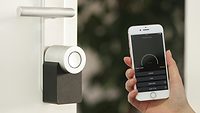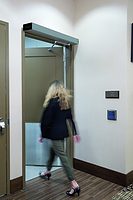Education & Training
Vertical markets benefit from mobile and cloud access solutions

As an enabling technology for physical security, cloud connectivity can improve on-demand availability to software and data. For video surveillance, the cloud can reduce storage and maintenance costs with ready access to live camera feeds and recorded video. In electronic access control deployments, leveraging the cloud can bring flexibility to remote issuance and enable mobile credentials for keyless entry at the edge.
With cloud-based access control, organizations can expand access with edge-controlled doors and smartphone apps for user access.
Without dependency on a head-end system at the protected premises, smart edge readers with cloud and mobile technologies can reduce hardware and labor costs while simplifying remote management of users with secure access across locations and facilities.
Readers with Bluetooth or Near Field Communications (NFC) can allow security teams to manage and control access to virtually anything, since such readers can operate autonomously with just mobile credentials that function as a user’s digital smart key for day and time scheduled access. Being able to control access to doors, gates and electrified locks or latches with only local power and no need for network connectivity can also simplify keyless entry deployment options.
Though cloud-based solutions offer users easy access to systems and data from virtually any location, including the ability to leverage mobile apps; scalability without much upfront investment in technology; and quick installations because locations do not require an onsite server, there are times when a cloud-based access control system might not make the most sense. Examples could be highly secure facilities, such as data centers, or large-scale enterprise access control customers, such as hospitals who have already made a considerable investment in on-premise servers. In that case, organizations wouldn’t necessarily realize the cost-savings of implementing a cloud solution, since significant on-premise investments have already been made.
However, for organizations in a number of vertical markets, including retail, fitness, multi-tenant and college campuses, the benefits of mobile and cloud-based access control can be significant.
Multifamily Residential and Property Management — Each time a tenant leaves and a new renter moves in, doors need to be rekeyed. This practice also extends to reprogramming cards, fobs or PINs for common areas or front entrances of gated communities. In a location with a high rotation of people, the cost of issuing cards and fobs and managing PINs can escalate quickly, while lost keys increase security risk. Cloud-managed keyless entry can eliminate the need for facility managers to rekey doors or manage lost keys.
Utilities/Telecom Co-Location Spaces — Remote sites, facilities or service closets that reside off corporate-managed real estate locations often rely on physical lock and keys, especially those with no local IT network access. With an electrified lock and intelligent reader paired with mobile cloud technology, remote facilities can leverage single devices that are network-connected to manage user access.
24-Hour Fitness Centers/Gyms/Health Centers — With a fluid and readily-changing membership or visitor base, mobile technology can allow users to access gyms, lockers and other areas with their smartphones. Facility managers can manage and reprogram access remotely.
Universities — By leveraging smartphone-based credentials and wireless locks, a college campus can control, manage and restrict access without magnetic stripe or smart card issuance. Mobile credentials can also provide convenience to a population already using their mobile devices for daily tasks.
Marinas and RV Parks — With the goal of restricting access to high-value assets, users at these types of properties can log into the cloud for record-keeping reports of access and can also revoke or reinstate access permissions remotely.
Standalone Kiosks and Shop-and-Go Retail — Similar to the Amazon Go concept, another emerging application for cloud-managed mobile access is unattended retail locations, which can be found in shopping malls or within an existing building, such as an airport. These kiosks and shop-and-go retailers can allow users to make purchases and pickups without an attendant present. Access to a pickup locker can automatically be revoked after a package has been retrieved.
For vertical markets that can deploy mobile access and cloud-based access control, such deployments reduce hardware and network dependencies on premises and present opportunities for security and facility managers to manage access remotely as well as deploy access at the edge in individual, remote or changing locations.
As the pace of innovation accelerates, smart edge technology for access control applications will continue to improve with additional capabilities, including leveraging analytics and artificial intelligence already available through the cloud.
Looking for a reprint of this article?
From high-res PDFs to custom plaques, order your copy today!







